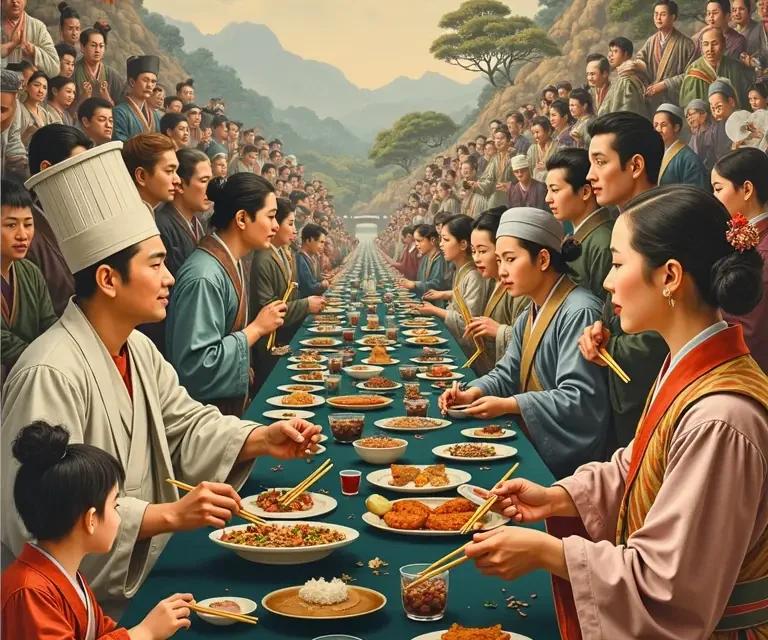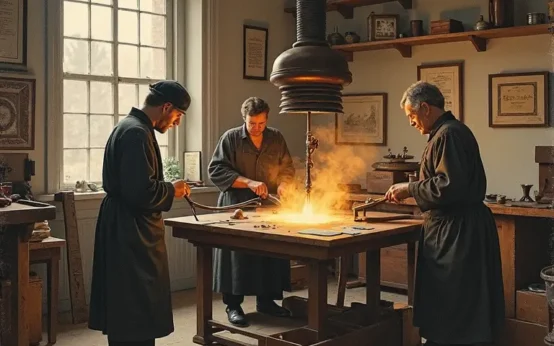Chopsticks. Those slender, tapered tools are synonymous with East Asian cuisine, but their story is far more complex and globally intertwined than many realize. From humble beginnings as cooking utensils to becoming deeply embedded cultural symbols, chopsticks have a history spanning millennia, marked by evolution in material, form, and etiquette. This article will delve into the surprisingly global history of chopsticks, exploring their origins, spread, cultural significance, the engineering behind their use, and the fascinating etiquette that governs their employment.
From Cooking Sticks to Tableware: The Early History
The earliest known precursors to chopsticks weren’t used for eating at the table at all. Archaeological evidence suggests that around 1200 BCE, during the Shang Dynasty in China, sticks were used for cooking – specifically, for retrieving food from boiling pots. These early chopsticks were likely made of bronze and were used to stir the fire, reach into hot liquids, and grab pieces of food. They weren’t yet the individualized eating implements we know today.
The transition from cooking sticks to tableware occurred gradually. As populations grew and resources became strained, larger, communal dishes became more common. Cutting meat into small, bite-sized pieces during cooking – a practice that arose partially from resourcefulness and partially from the difficulty of using knives at the table – meant that individual diners could easily pick up their portions with sticks. By the Han Dynasty (206 BCE – 220 CE), chopsticks were becoming increasingly common as eating utensils, though spoons were still favored for soups and other liquids.
The development of chopsticks also coincided with changes in Chinese cuisine. The practice of chopping food into smaller pieces, already mentioned, gained prominence, making chopsticks a more practical and efficient tool. This culinary shift reinforced the adoption of chopsticks, and the two evolved together. The use of chopsticks also encouraged a slower, more mindful style of eating, a concept deeply embedded in East Asian food culture.
The Spread of Chopsticks: A Journey Across Asia
From China, the use of chopsticks spread throughout East Asia, adapting and evolving along the way. Vietnam adopted chopsticks relatively early, influenced by its proximity to China and centuries of cultural exchange. Korean chopsticks, known as jeotgarak, are typically made of metal – historically silver, stainless steel, or brass – a practice distinct from the wooden or bamboo chopsticks common in China and Japan. The adoption of metal chopsticks in Korea is thought to be linked to concerns about poisoning by political enemies; metal would change color in the presence of certain toxins.
Japan’s adoption of chopsticks, known as hashi, occurred around the 8th century CE, during a period of significant cultural import from China. Initially, chopsticks were primarily used by the upper classes and Buddhist monks. Over time, their use spread throughout Japanese society. Japanese chopsticks tend to be shorter and tapered to a finer point than Chinese chopsticks, reflecting the Japanese preference for eating directly from the plate or bowl rather than reaching for communal dishes.
The spread wasn’t simply eastward. Trade routes and migration patterns carried chopsticks – and the associated culinary traditions – further afield. While not becoming dominant dining tools, chopsticks found a niche in some Southeast Asian cuisines, particularly in areas with significant Chinese diaspora populations. Even today, you can find chopsticks readily available in many restaurants across Southeast Asia.
Materials and Engineering: The Science of Grasping
The materials used to make chopsticks have varied considerably over time and across cultures. Early chopsticks were made of bronze, as mentioned, but wood and bamboo quickly became the dominant materials due to their affordability, availability, and ease of manufacture. Ivory, jade, and even gold were used for chopsticks made for the elite, signifying status and wealth. Modern chopsticks are often made of plastic, stainless steel, or composite materials.
But the choice of material isn’t merely aesthetic or economic; it impacts the functionality of the chopsticks. The slight texture of wood and bamboo provides a degree of friction, helping to grip food. The flexibility of these materials also allows for a degree of “give,” making it easier to manipulate slippery items like noodles. Metal chopsticks, while durable and hygienic, can be more slippery and require greater dexterity.
The shape of chopsticks is also a result of careful engineering – even if that engineering wasn’t consciously applied at first. The tapered end is designed to reduce the force needed to pick up food. The rounded or square shape of the handle affects grip and comfort. The length of the chopsticks is also important, varying based on cultural preferences and the typical style of dining. A longer chopstick allows for reaching into communal dishes, while a shorter chopstick is more suited for individual plates.
Chopstick Etiquette: A Minefield of Social Norms
Perhaps the most fascinating aspect of chopsticks is the elaborate etiquette surrounding their use. These rules aren’t simply arbitrary; they reflect deeply held cultural values relating to respect, harmony, and social hierarchy. Violating chopstick etiquette can be considered deeply rude and even offensive.
Here are just a few examples:

- Don’t stick chopsticks upright in your rice bowl. This resembles incense sticks offered to the deceased and is considered extremely bad luck.
- Don’t pass food directly from your chopsticks to another person’s chopsticks. This is reminiscent of a funeral ritual where bones are passed after cremation.
- Don’t use chopsticks to spear food. Pick it up gently.
- Don’t wave chopsticks around or use them to point.
- Don’t rest your chopsticks across your bowl. Rest them horizontally on a chopstick rest (hashioki in Japan) or on the side of your plate.
- Don’t lick your chopsticks.
- Don’t hover your chopsticks over dishes, deciding what to take. Make a decision and take it.
These rules vary slightly between cultures. For example, in some cultures, it’s acceptable to use chopsticks to move dishes closer to you, while in others it’s considered impolite. Understanding these nuances is crucial for navigating social situations and showing respect for local customs.
Chopsticks and Cultural Identity
Beyond their practical function, chopsticks have become potent symbols of cultural identity. They represent not just a way of eating but a way of life, embodying values such as patience, mindfulness, and communal harmony. The act of sharing food with chopsticks reinforces social bonds and promotes a sense of togetherness.
In many East Asian cultures, chopsticks are seen as an extension of the hands, and their proper use is considered a mark of refinement and good manners. Teaching children how to use chopsticks correctly is an important part of their upbringing, instilling in them a sense of cultural pride and responsibility. The continued use of chopsticks, even in a world increasingly dominated by Western cutlery, is a conscious affirmation of cultural heritage.
The Modern Chopstick: Sustainability and Innovation
The ubiquitous disposable wooden chopsticks, a hallmark of many Asian restaurants, have come under scrutiny in recent years due to environmental concerns. The mass production of these chopsticks contributes to deforestation and waste. This has led to a growing movement promoting the use of reusable chopsticks, made from materials like bamboo, stainless steel, and even recycled plastics.
Innovation in chopstick design continues. Some companies are developing chopsticks with improved grips, ergonomic handles, and even built-in sensors to monitor eating speed and portion size. Others are exploring sustainable materials and manufacturing processes to reduce the environmental impact of chopstick production. The future of chopsticks is likely to be marked by a greater emphasis on sustainability, functionality, and cultural sensitivity.
Chopsticks in a Globalized World
The story of chopsticks is a testament to the power of cultural exchange and adaptation. What began as cooking sticks in ancient China has evolved into a globally recognized symbol of East Asian cuisine and culture. Their spread across Asia, and increasingly to the rest of the world, demonstrates the enduring appeal of this simple yet elegant tool.
The continued popularity of chopsticks isn’t just about practicality; it’s about embracing a different way of experiencing food and connecting with a rich cultural heritage. Whether you’re a seasoned chopstick user or a curious beginner, understanding their history and etiquette offers a fascinating glimpse into the heart of East Asian culture.
Want to learn more about the history of everyday objects? Check out the surprisingly detailed history of buttons!
The strategic thinking behind even childhood activities is fascinating. Discover the surprisingly strategic roots of playground games.
Speaking of physics, have you ever wondered about the science behind something seemingly simple? Explore the curious physics of bubbles.
Even things we take for granted have hidden histories. Learn about the unexpectedly political history of fonts.
And don’t forget the stories behind our traditions! Dive into the unexpected origins of nursery rhymes.


 The Curious Acoustics of Historical Echo Chambers: Resonance, Ritual, and Revelation
The Curious Acoustics of Historical Echo Chambers: Resonance, Ritual, and Revelation  The Curious Cartography of Scent: Mapping Perfume Ingredients Through History
The Curious Cartography of Scent: Mapping Perfume Ingredients Through History  The Curious Lexicon of Lost Trades
The Curious Lexicon of Lost Trades  The Surprisingly Consistent Science of Historical Ice Harvesting – A Frozen History of Commerce & Preservation
The Surprisingly Consistent Science of Historical Ice Harvesting – A Frozen History of Commerce & Preservation  The Unexpectedly Consistent Science of Historical Buttonhooks – Fashion, Function & Forgotten Tools
The Unexpectedly Consistent Science of Historical Buttonhooks – Fashion, Function & Forgotten Tools  The Surprisingly Consistent Science of Historical Toy Soldiers – Miniature Warfare, Materials & Collective Play
The Surprisingly Consistent Science of Historical Toy Soldiers – Miniature Warfare, Materials & Collective Play